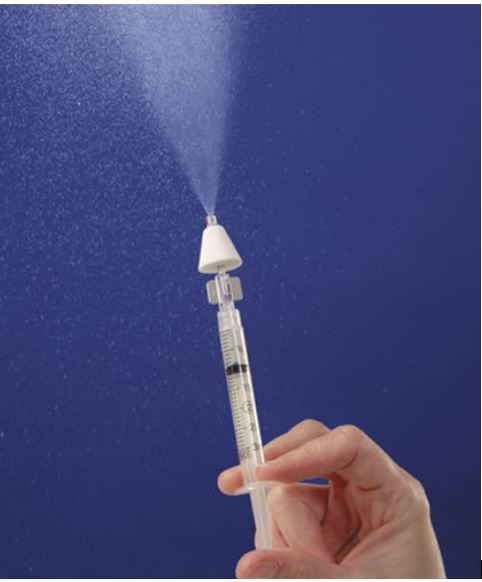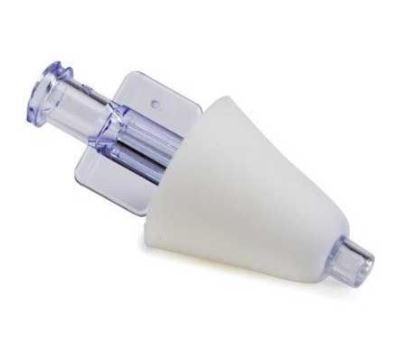INTRANASAL MUCOSAL ATOMIZATION DEVICE, without syringe
Valid Article
INTRANASAL MUCOSAL ATOMIZATION DEVICE
Definition
An easy-to-use and effective device for administering nasal medication to children.
It creates a seal with the nostril, allowing for the delivery of atomised drug particles to the nasal mucosa. The particles are then absorbed through the mucosa and directly into the bloodstream, avoiding first pass metabolism.
Single patient multiple use device
Synonym
MAD Nasal 300 (Teleflex), DART 300 (Pulmodyne)
Specifications
Foam applicator containing a plastic aerosoliser that attaches to the syringe containing the medication. When the plunger of the syringe is pressed, the medication is sprayed through the aerosoliser and turned into a mist.
Luer-lock tip to connect a pre-filled Luer-lock syringe.
Technical specifications
- Conical plastic plug with foam envelope that forms a seal with the nostril, preventing the expulsion of fluid
- Flexible stylet allows the nasal plug to be positioned 180º
- Atomiser releases medication in a fine mist of 30-100 µ particles
- System dead space: 0.06 ml or 0.16 ml (depending on the model)
- Tip diameter: 4.3 mm
- Applicator length: approx 4 cm
- Luer-lock tip
- Non sterile, for single-use
Packaging & Labelling
Box of 25 or 50 pieces (depending on the manufacturer)
To be Ordered Separately
Luer-lock syringes
Instructions for use
Procedure for intranasal administration:
- Fill a single-use Luer-lock syringe with the required volume of medicine (including an extra 0.1 ml to compensate for the dead space volume of the device). Ensure all air is removed from the syringe.
- Remove the needle from the syringe.
- Connect the atomization device to the syringe using the Luer-lock connector. Twist the connector to secure it in place.
- Position the child either on their back or in a seated position.
- Hold the top of the child's head stable. Insert the tip of the device into one nostril, angling it slightly upwards and towards the ear on the same side of the head.
- Administer half of the dose into the first nostril by pressing the syringe plunger firmly to maximise the atomisation.
- Repeat he process in the other nostril to deliver the remaining dose.
Repeating a dose:
If a dose needs to be repeated, the remaining 0.1 ml of medication in the device should be expelled:
- Disconnect the device from the syringe. Fill the syringe with 1 ml of air and reattach the device.
- Press the plunger of the syringe firmly and repeat the process until all the medication is expelled.
Refer to the manufacturer's instructions for use.
Precautions for Use
Do not exceed the recommended dosage of 0.5 to 1 ml of medication per nostril (ideal volume being 0.2 to 0.3 ml per nostril). If a higher volume is necessary, split the dosage into two separate administrations, allowing for absorption between each dose.
When administering the medication, divide the dose equally between both nostrils. The method increases the surface area, speed, and absorption of the medicine.
For small doses, consider the "dead space" when calculating the volume of medication to be given.
In case of excessive secretion or nasal trauma, aspirate the nasal cavity or consider alternative routes of administration.
Mucous, blood, and vasoconstrictors may reduce the absorption of the medication.
The same device can be reused for multiple doses in the same patient. Do not reuse the device if the medication has been changed.
Storage
Keep in the original packaging protected from dust, heat and light.
MSF requirements
Device recommended by MSF anaesthetists and critical care referents for children with medical complexity often requiring multiple medications, some prescribed as an intranasal mist (e.g. midazolam, fentanyl).





![[KMEDMSUP05S] (IEHK 2024 suppl. module) SUPPLEMENTARY RENEWABLE UNIT](/web/image/product.template/583185/image_256/%5BKMEDMSUP05S%5D%20%28IEHK%202024%20suppl.%20module%29%20SUPPLEMENTARY%20RENEWABLE%20UNIT?unique=7995f43)
![[DINJMIDA50A] MIDAZOLAM, 5mg/ml, 10ml, amp](/web/image/product.template/577678/image_256/%5BDINJMIDA50A%5D%20MIDAZOLAM%2C%205mg-ml%2C%2010ml%2C%20amp?unique=89882c9)
![[DINJMIDA5A-] MIDAZOLAM, 1mg/ml, 5ml, amp](/web/image/product.template/572197/image_256/%5BDINJMIDA5A-%5D%20MIDAZOLAM%2C%201mg-ml%2C%205ml%2C%20amp?unique=abdf170)
![[SINSSYLL01-] SYRINGE, Luer-lock, 1 ml, s.u.](/web/image/product.template/577791/image_256/%5BSINSSYLL01-%5D%20SYRINGE%2C%20Luer-lock%2C%201%20ml%2C%20s.u.?unique=7995f43)
![[SINSSYLL03-] SYRINGE, Luer-lock, 3 ml, s.u.](/web/image/product.template/577792/image_256/%5BSINSSYLL03-%5D%20SYRINGE%2C%20Luer-lock%2C%203%20ml%2C%20s.u.?unique=81bca4f)
![[SINSSYLL05-] SYRINGE, Luer-lock, 5 ml, s.u.](/web/image/product.template/571801/image_256/%5BSINSSYLL05-%5D%20SYRINGE%2C%20Luer-lock%2C%205%20ml%2C%20s.u.?unique=e021bd7)